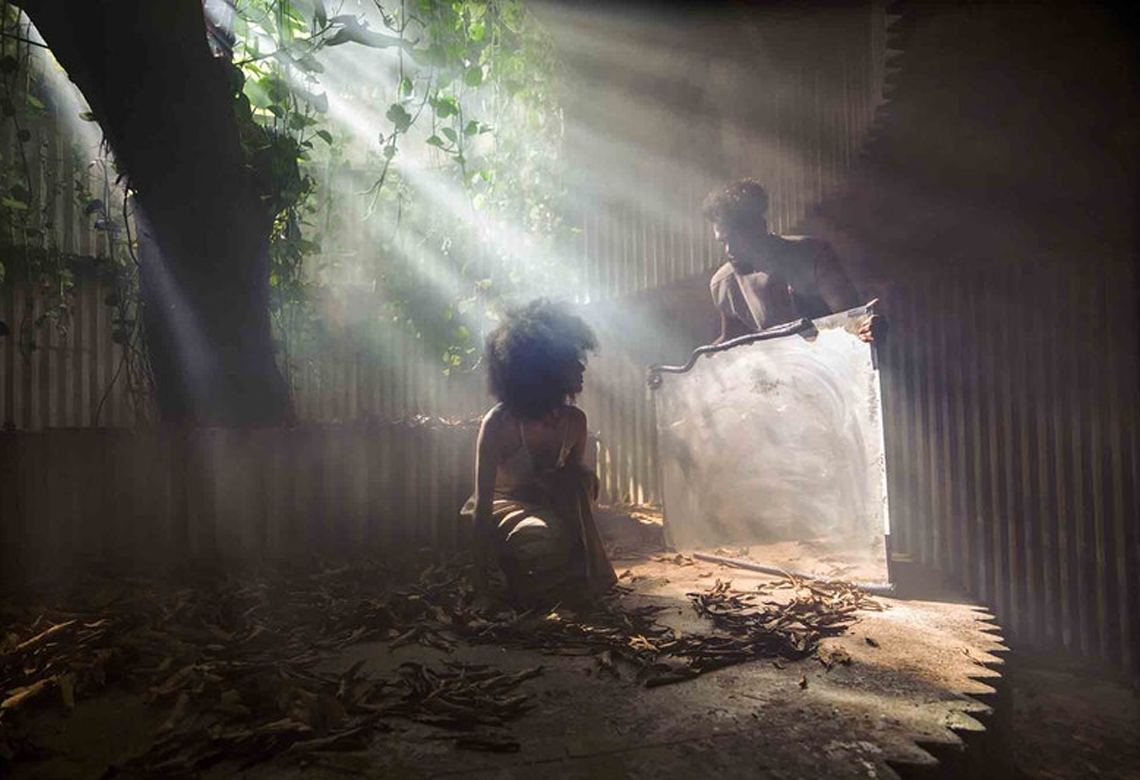University of California Santa Cruz professor Isaac Julien’s newest Film Marvellous Entanglement stretches the narrative limits of film
University of California Santa Cruz professor Isaac Julien’s newest Film Marvellous Entanglement stretches the narrative limits of film
February 4, 2022If film is a bearer of time’s chronological build-up, it is also the medium that can best dismantle this supposed linearity. In recent decades, no other artist, perhaps, has dedicated their career to film’s ability to poetically disrupt time like Isaac Julien. The British artist’s absorbing moving images in sculptural displays take us from one moment to the other, zooming us suddenly back to what we thought was bygone, only to confront us with another instant before it flees. Julien achieves a kind of Proustian anarchism that resists the seconds piling into minutes, while simultaneously knocking down the house-of-cards construction of insistent temporality with his gentile edits.
A maestro of internal time, Julien is unsurprisingly fascinated by Lina Bo Bardi, the 20th-century Italian Brazilian architect whose defiance of any continuous chronology is best captured in her famous quote: “Linear time is a western invention. Time is not linear, it is a marvelous entanglement, where at any moment, points can be chosen and solutions invented, without beginning or end.”
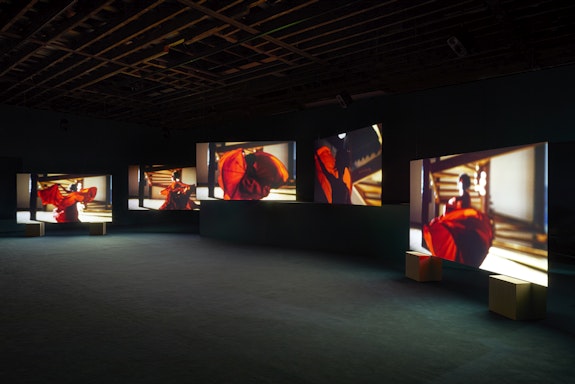
Isaac Julien, Lina Bo Bardi – A Marvellous Entanglement, 2019. Nine-screen installation, super-high definition, colour, 9.1 surround sound. 39 min 08 sec. © Isaac Julien, courtesy the artist and Victoria Miro, London/Venice.
In the fickle moment, architecture attempts to pause and embody the flow of time, erecting a concrete body as a witness. While many modernists broke ground to craft structures of impersonal power, Bo Bardi chose fluidity over imposition and the specificity of the body over abstract homogeneity. Julien’s love song to the Brazilian architect’s life and philosophy is his most recent film installation, Lina Bo Bardi — Marvellous Entanglement (2019), which is currently on view at the Bechtler Museum of Modern Art in Charlotte, North Carolina.
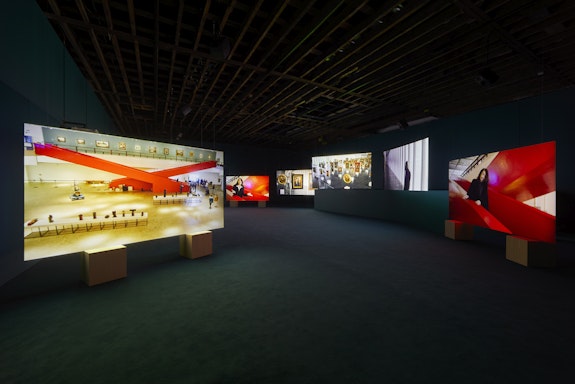
Isaac Julien, Lina Bo Bardi – A Marvellous Entanglement, 2019. Nine-screen installation,super-high definition, colour, 9.1 surround sound. 39 min 08 sec. © Isaac Julien, courtesy theartist and Victoria Miro, London/Venice
Nine large scale screens form an enclosed circle as the film’s two actresses, Brazil’s mother-and-daughter duo of acting divas Fernanda Montenegro and Fernanda Torres, embody Bo Bardi in different stages of her life. The screens stand on concrete blocks in an homage to the style in which Bo Bardi famously installed classical European paintings: she mounted them onto glass planes standing on concrete blocks in the main gallery of her architectural masterpiece, the Museu de Arte de São Paulo. For decades after, the museum instead exhibited the paintings in a traditional fashion, but Bo Bardi’s remarkable institutional accent was finally reinstated a few years ago.
Julien’s camera takes advantage of this restored installation, maneuvering around lush landscapes and glorious portraits that seem to be floating in the air. This sense of weightlessness prevails throughout the 40-minute film, which synthesizes dance with architecture, reality with fiction, and imagination with history. The word synthesize aptly describes the auditory sensations of the film as well. The sound fluctuates from fast-beat abstract compositions to serenity, peppered with monologues citing Bo Bardi’s ideas about life and work. Casting two actresses from the same family not only creates a physical connection between the architect’s younger and older selves, but also adds another layer of emotion to the actresses’ deliveries.
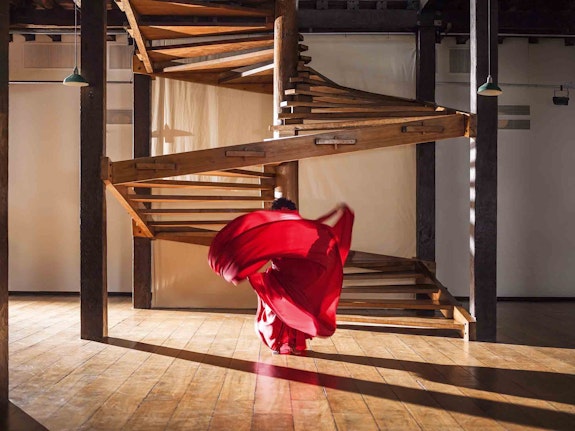
Isaac Julien, O que é um museu? / What is a Museum? (Lina Bo Bardi – A Marvellous Entanglement), 2019. Endura Ultra photograph facemounted. ©Isaac Julien. Courtesy the artist and Jessica Silverman Gallery
Typical of any Julien picture, Marvellous Entanglement stretches the narrative limits of film and instead presents moving versions of all forms of art—including photography, dance, painting, and sculpture. The intestine-like tube bridges of Bo Bardi’s bodily SESC Pompéia building evoke Grecian sculpture, while its ruby-colored cut-out windows recall Abstract Expressionist paintings. A dancer deliriously twirls inside a light-filled space, her shroud (also ruby-colored, an anchoring hue throughout the film which refers to the two iconic beams of Museu de Arte de São Paulo) frantically waving as if to create painterly gestures in the air. Another group of dancers occupy the steps of a swirling staircase—each dons white attire as they familiarize themselves with their surroundings.
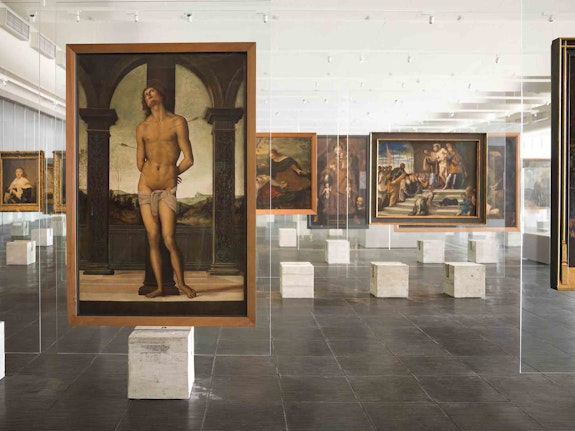
Isaac Julien, Sem começo nem fim / Without Beginning or End (Lina Bo Bardi – A Marvellous Entanglement), 2019. Endura Ultra photograph facemounted. ©Isaac Julien. Courtesy the artist and Jessica Silverman, San Francisco
Finding new potential in Bo Bardi’s interiors and façades, Julien expands the borders of architecture just as he usually expands those of film. Across staggered screens, movement, color, and sound activate lofty spaces and smooth facades. Time feels liquid and mercurial. Moments and years in the architect’s life bleed into the corners that she built. Later, they blend into one another, so much so that two versions of Bo Bardi encounter one another on the stage at Teatro Oficina, where the seats, as Montenegro’s Bardi explains, were designed in wood to deprive the audience of comfort while making them actively conscious of the play.
